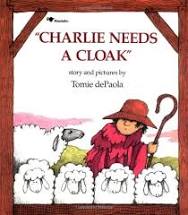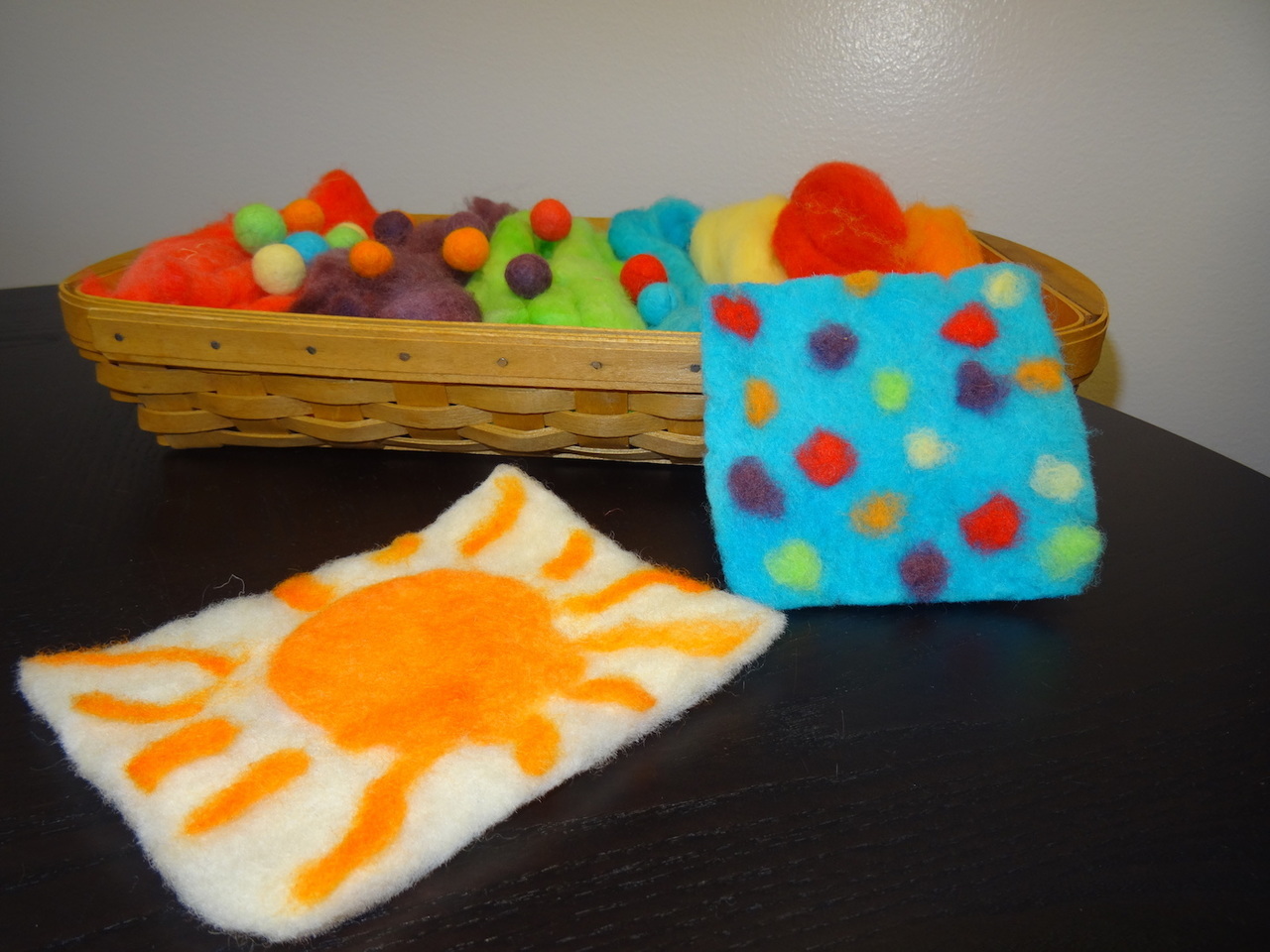Agricultural Literacy Curriculum Matrix
Lesson Plan
Baa, Ram, Ewe... Sheep Tales
Grade Level
Purpose
Students explore the process of making wool into cloth. Grades K-2
Estimated Time
Materials Needed
Engage:
- Wool sample* (optional)
*A Wool Sample Kit is available for purchase from agclassroomstore.com.
Activity 1: Charlie Needs a Cloak
- Charlie Needs a Cloak by Tomie DePaola
Activity 2: Sheep to Sweater
- Sheep to Sweater activity sheet, 1 per student
- Scissors
- Glue sticks
- How Wool is Made into Fabric video
Activity 3: Dyeing and Felting Wool
- Wool;* cut to one arm's length
- 1 Tbsp vinegar (15 mL)
- 1 cup water (240 mL)
- Glass bowl
- Microwave
- Kool-Aid
- 2" x 2" (5.08 cm x 5.08 cm) pieces of dyed wool,* 1 per student
- Bowl of warm, soapy water
- Natural and dyed wool
- Tulle fabric
- Sandwich-sized resealable bags, 1 per student
- Soapy water
*Carded wool can be purchased in a Wool Refill Kit from agclassroomstore.com.
Vocabulary
card: a process that smoothes and straightens wool fibers
ewe: a female sheep
fleece: the woolly covering of a sheep
lamb: a young sheep
ram: a male sheep
shear: cut the wool off
shepherd: a person who cares for sheep
wool: the fine, soft, curly or wavy hair forming the coat of a sheep, goat, or similar animal used in making cloth or yarn
Did You Know?
- Lanolin is a natural oil in sheep's wool. It is used in cosmetics and lotions.
- White is the most valuable color of wool because it can be dyed any color.
- Sheep meat is called "lamb" if it was harvested while the animal was young, or "mutton" if it was harvested when the animal was old.
Background Agricultural Connections
Sheep are grazing animals. A male sheep is called a ram. A female sheep is called a ewe (pronounced “you”). A baby sheep is called a lamb. Lambs are born in the spring. Ewes often have twin lambs; occasionally, they will have triplets. If the mother cannot give her lambs enough milk, a shepherd may decide to raise the lamb on a bottle. These lambs are often called “bum lambs.” When sheep are bottle-fed, they become tame.
It is important to shear sheep before their lambs are born. It can be difficult for the new lambs to drink milk with a lot of wool in the way. Sheep shearing is a unique job. It is generally performed by a professional shearer. It takes a whole year for sheep to grow a heavy fleece. A sheep’s fleece usually weighs about eight pounds. When the sheep is sheared, the shearer tries to keep the fleece in one piece. The sheep is held in a special way so that neither the sheep nor the shearer get hurt. Giving the sheep a “hair cut” allows the sheep to be cooler in the summer months and keeps insects and other pests from living in the thick wool. After the sheep is sheared, the wool is washed, carded, dyed, spun into yarn, and woven into fabric. Wool can also be felted, a process of matting fibers together, to make products such as hats, slippers, and ornaments.
Engage
- Ask the students, "What animal produces wool?" Once they identify that sheep produce wool ask, "What is wool used for?"
- If possible, point out any clothing, socks, or coats in the room that are made of wool. You may also provide a sample of wool for the students to see and touch.
Explore and Explain
Activity 1: Charlie Needs a Cloak
- Explain to the students that a shepherd is a person who cares for sheep. Tell the class that they are going to look at a book about a shepherd named Charlie.
- Covering up the words
 of the story, project the pictures of the book Charlie Needs a Cloak by Tomie DePaola onto a large screen. Ask the class to describe what they think is happening on each page of the book.
of the story, project the pictures of the book Charlie Needs a Cloak by Tomie DePaola onto a large screen. Ask the class to describe what they think is happening on each page of the book. - Read the story aloud to the class two times. After the first reading, ask the students to compare the actual story with their original descriptions of the illustrations.
- When reading the story a second time, provide the following additional information about each process of wool production:
- Page 1: A shepherd is a person who cares for sheep.
- Pages 2-3: A cloak is a coat without sleeves.
- Pages 8-9: During the winter, the wool of sheep grows thick and heavy to keep the animals warm. In the spring when the weather begins to warm up, sheep no longer need their wool. Farmers or professional shearers cut or shave the wool off the sheep. This process is called shearing.
- Pages 10-11: Wool is washed to clean out any impurities.
- Pages 12-13: Special brushes called carding brushes are used to card wool, making the wool fibers smooth and straight. After the wool is carded, it is divided into thin, round strips called roving.
- Pages 14-15: Wool roving can easily be pulled apart. To strengthen the wool, it is spun into yarn.
- Pages 16-17: Wool is very absorbent which makes it easy to dye. Wool can be dyed any color.
- Pages 18-21: Wool yarn is woven on a loom to make cloth.
- Pages 22-31: The wool cloth can be cut, pinned, and sewn to make clothing like Charlie's new cloak.
Activity 2: Sheep to Sweater
- Provide each student with a copy of the Sheep to Sweater activity sheet.
- Have the students cut out each of the pictures and order them to show how the wool in the story Charlie Needs a Cloak was processed. It may be useful for students to reference the pages in the story as they order the pictures.
- When the students have the correct sequence from sheep to sweater, instruct them to glue the pictures onto the sheep in order.
- Explain to the students that the boxes containing the letter ‘M’ show tasks that are performed by machines when wool is processed in large quantities.
- View the How Wool is Made into Fabric video to see how machines are used to process wool.
Activity 3: Dyeing and Felting Wool
- Explain to the students that wool can also be made into fabric through a process of matting fibers together called felting. Wool products such as hats, slippers, and ornaments can be made using this process.
- Tell the students that they will have an opportunity to dye and felt wool.
- Dyeing Wool
- In a glass bowl, combine 1 package of Kool-Aid, 1 cup of water, and 1 tablespoon of vinegar. Stir until the Kool-Aid completely dissolves.
- Fully immerse an arm's length of wool into the Kool-Aid mixture.
- Place the bowl of wool and Kool-Aid mixture into a microwave. Heat on high for two minutes.
- Remove the bowl from the microwave and allow to cool. BE CAREFUL; IT'S HOT!
- After the mixture has cooled, rinse the wool in cold water and allow to dry.
- Felted Wool Marbles
- Separate the fibers from a 2" x 2" (5.08 cm x 5.08 cm) piece of dyed wool until you have a puff of wool.
- Lightly and gently roll the wool in your hands to create a loose ball.
- Dip the wool into warm, soapy water.
- Roll the wool between your palms in a gentle but quick circular motion. Do not press or squeeze the wool.
- Continue rolling until the wool starts to stick together and looks like felt. This should take about five minutes.
- Allow the marble to dry.
- Ziploc Felting
- Cut a rectangular, flat piece of wool small enough to fit inside the resealable bag.
- Create a design by layering dyed wool on top of the rectangular piece.
- Place rectangular pieces of tulle on the top and bottom of the wool. This will help speed up the felting process.
- Place the wool and tulle inside the bag.
- Pour enough soapy water into the bag to completely saturate the wool.
- Place the bag flat onto a towel.
- Squeeze the excess water out of the bag by pressing with your hand from the bottom of the bag to the top.
- Seal the bag and work the wool by poking and pounding with your hands from the oustside of the bag until the wool becomes firm and felt-like.
- After the wool has felted, remove it from the bag, discard the tulle, and gently rinse in water, alternating hot and cold.
- Roll the felt in a towel to squeeze out any excess water. Lay flat to dry.

Elaborate
- Have the students read and compare what they have learned with one or many of the books listed as Suggested Companion Resources. The book Warm as Wool shows how a mother makes warm woolen clothing for her children. She does the work by hand. Long ago, people only had a few pegs on which to hang their clothes. Ask the students if they know why children only had one or maybe two pairs of pants, a couple of shirts, and a single pair of socks. (There were many steps for making one article of clothing—reference the Sheep to Sweater activity sheet.)
- Display samples of wool in various stages of processing.
- Watch a sheep shearing demonstration or other video clips about sheep production with your students such as America's Heartland–Bachelor Sheep Ranch or America's Heartland–Sheep Special.
Evaluate
After conducting these activities, review and summarize the following key concepts:
- Sheep produce wool.
- When sheep are sheared, their wool is cut or shaved off.
- Wool is used to make yarn and fabric for sweaters, coats, socks, hats, blankets, carpets, rugs, firefighters' uniforms, etc.
Recommended Companion Resources
- A New Coat for Anna
- A Young Shepherd
- About...Books
- America's Heartland: Wild & Wooly Roundup
- Brave Dogs, Gentle Dogs
- Charlie Needs a Cloak
- Ewe Bee Ewe: A Sheep Tail
- Farm Animals in a Box
- Farm Animals: Sheep
- Farm Pop-Ups
- From Sheep to Sweater
- Hands-On With Wool
- Homespun Sarah
- If You Want to Knit Some Mittens
- Sheep Crossing
- Sheep on the Farm
- Sheepology: The Ultimate Encyclopedia
- The Surprise
- Warm as Wool
- Weaving the Rainbow
- Where Did My Clothes Come From?
- Wild Rose's Weaving
- Wool Ewe Keep Me Warm? Video
- Wool Samples
- Wool Spinning Kit
Author
Organization
| We welcome your feedback! If you have a question about this lesson or would like to report a broken link, please send us an email. If you have used this lesson and are willing to share your experience, we will provide you with a coupon code for 10% off your next purchase at AgClassroomStore. |
